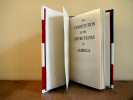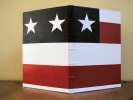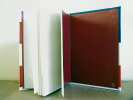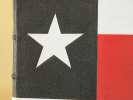


21.8 x 15.2 x 1. 5 cm
United States Constitution sewn on five raised cords, with covers laced on. Bound in American flag pattern in a combination of inlays and back-pared onlays. Hand-stitched headbands and silk-pattern endpapers.
This is the first time I have let my politics get involved in my bookbinding. Without getting into the issues involved, I will simply say that I thought it would be a good idea to do a really beautiful binding of the US Constitution and send it to the President.
The text of the Constitution and its amendments is readily available online. I used the version available at the House of Representatives website. After reformatting the text, I printed it out on our inkjet printer, onto fine laid paper.
The paper I used was cross-grained, meaning that the grain ran perpendicular to the spine rather than parallel. (This is a common problem with ordinary stationery - the grain runs in the long direction, so turning it on its side and folding it in half crosses the grain.) Although some binders will tell you that this is Instant Death for a book, the problem can be managed with careful moisture control. I pretty much made it, though there are some characteristic wrinkles on a few pages.
I sewed the book on five raised cords, trimmed the foredge, rounded and backed it, and trimmed the head and tail. In the past, I have tended to over-shoulder my books when backing, but in this case I managed to get the shoulders right for the board thickness.
 I knew from fairly early on that I wanted to do a design based on the United States flag. But I also knew that cutting 50 stars out of leather would make me lose the will to live. So I decided to go with my recent trend of using close-ups of recognisable designs, and make the cover out of a small section of the flag. The most interesting place on the flag, visually, is the bottom right corner of the blue field, where it meets the red and white stripes.
I knew from fairly early on that I wanted to do a design based on the United States flag. But I also knew that cutting 50 stars out of leather would make me lose the will to live. So I decided to go with my recent trend of using close-ups of recognisable designs, and make the cover out of a small section of the flag. The most interesting place on the flag, visually, is the bottom right corner of the blue field, where it meets the red and white stripes.
I decided to do the cover in two pieces:
This structure took advantage of the fact that the only true red leather I had was skiver, too thin to be used on its own next to the white and blue. My usual skittishness about many pieces of different leather on a book cover wasn't really the issue, because I generally have problems with curved joins. Even if I had done the stripes one by one, all the joints would have been straight.
 The blue section went like a dream. I pared the white leather thin and stabilised it with fine rice paper before pasting it onto the blue leather (before the book was covered). Then I pared and sanded the back side of the blue until the star was flush with the surface. I also pared the hinges and spine area.
The blue section went like a dream. I pared the white leather thin and stabilised it with fine rice paper before pasting it onto the blue leather (before the book was covered). Then I pared and sanded the back side of the blue until the star was flush with the surface. I also pared the hinges and spine area.
The white section was more of a nightmare. The red skiver has a glossy finish and a rather delicate structure. I felt that I might damage it too much if I pared it thinner before pasting it to the white. Unfortunately, the skiver, while too thin to stand on its own next to the white and blue, was thick enough to make back paring difficult. In the end, I found myself cutting through the white leather in patches, particuarly at the board edges, spine and hinges. I even found myself paring the skiver back a tiny bit.
Unfortunately, you can't pare that skiver back a tiny bit, or the moisture darkens the surface when you paste the assemblage down to the boards. I finished pasting the white leather down and found dark spots all over the red stripes. The only solution was, after the book was dry, to gently peel the red leather off of the white, sand down the unevennesses, fill any gaps with paper, sand again, and paste new red leather down. That turned out perfectly, much to my relief.
I added my maker's mark on the inside of the back cover. I decided not to title the book in gold, for three very good reasons.
The flag should never have placed upon it, nor on any part of it, nor attached to it any mark, insignia, letter, word, figure, design, picture, or drawing of any nature.
Mostly reason 3...
I have since made five more for sale, fixing all of the structural and design flaws in this one.